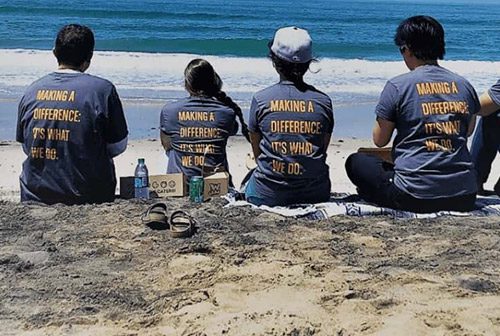San Diego Coastkeeper Education and Marine Debris Manager Alicia Glassco caught up with her friend, Miriam Goldstein, chief scientist on the Scripps Environmental Accumulation of Plastic Expedition (SEAPLEX) and PhD student at the Scripps Institute of Oceanography at the University of California, San Diego, to get the latest scientific information on marine debris in the North Pacific Gyre. Coastkeeper works closely with scientists to ensure that we are up to date with the best available science in order to educate and inform the public, policy decision makers and industries.


There has been lots of media attention around the “Great Pacific Ocean Garbage Patch,” but there is currently little scientific information about the composition, extent and effects of marine debris. With a desire to find answers to these questions, the SEAPLEX voyage ventured out into the North Pacific Ocean Gyre to gain further insight on the plastics problem.
Alicia: Good morning! It was great to see you at the 5th International Marine Debris Conference! Are you working on publishing some of your research this year?
Miriam: Yes, I am working on publishing our research. In fact, the first paper from SEAPLEX came out in the Marine Ecology Progress Series last June. It’s by Pete Davison and Rebecca Asch and its on fish ingestion of plastic particles.
Alicia: Great! Sounds like you are making great progress – this paper should complement the publication from Algalita last year. It’s important to get different perspectives and new data sets on topics like these many of our members and volunteers are concerned about plastic entering the food chain.
Miriam: Absolutely – we all care about our oceans and need as much as information as possible to figure out solutions.
I should note that Pete and Rebecca’s paper looked at plastic found in fish stomachs not at toxins. Their results found evidence of plastic waste in more than 9 percent of stomachs of fish. Based on this rate of ingestion, they estimated that fish in the intermediate ocean depths of the North Pacific ingest plastic at a rate of roughly 12,000 to 24,000 tons per year.
Alicia: Wow, that’s incredible! It must have been hard work to trying to figure that out. One of the reasons Coastkeeper is working so hard to reduce plastic pollution is because those smaller pieces that seem to “disappear” are not gone forever. I know at your SEAPLEX cruise you found a lot of these little flecks thousands of miles off shore. Did you calculate a density of plastic for the area of the North Pacific Gyre?
Miriam: We found that density in the North Pacific Central Gyre varies a LOT. There can be 10 times more plastic in one area than in a similar area just a few miles away. This is probably because of oceanographic forces like the wind mixing the upper part of the ocean or small currents bringing particles together in certain places.
Alicia: Commenting on fish eating plastic: Did you ever see that Colbert Report interview with Charles Moore? Colbert said “Well, if plastic lasts forever, and you are what you eat, and the fish are eating plastic, does that mean they’re going to live forever?”
Miriam: Hahaha. Yes I did see that. To be all serious and boring, the fish that are eating plastic (lanternfish, called myctophids by scientists) don’t live very long naturally. It’s hard to be a tasty little fish in the great big ocean.
Alicia: Physical oceanography rules the oceans! I think its great that so many disciplines are coming together to address the issue of marine debris. I also appreciate all you’re doing to help Coastkeeper with making sure our science information is on track. Coastkeeper works hard to communicate our local issues and how San Diego contributes to the problem of marine debris (and how our trash is carried to far away ocean places). Many types of data contribute to that communication, including your research and notes. Thanks so much for your input!
Miriam: I think what Coastkeeper does is so important – thanks for letting me get involved!
Alicia: Good luck on your next cruise. Looking forward to following your blog!













